Lease paperwork has always been an uncertainty for landlords and property managers. Coordinating schedules, printing forms, chasing signatures, and storing physical copies slows everything down, particularly when multiple units or locations are involved.
Electronic lease signing changes that.
With digital signatures now legally recognized across the U.S., more property professionals are using secure online tools to manage rental agreements from end to end.
This guide breaks down how electronic lease signing works, what makes it legally valid, and how it improves efficiency for both landlords and tenants. You’ll also see the most common roadblocks, the tools leading the way, and how to choose the right platform based on your rental volume and workflow.
What is Electronic Lease Signing?
An electronic lease signing is a digital process that allows all parties to agree on rental agreements without handling printed documents. It replaces traditional pen-and-paper methods with online tools that facilitate faster and more efficient completion of rental contracts.
This way, landlords, tenants, and agents can review, approve, and finalize agreements to save time while reducing paperwork.
This form of agreement manages the signing process using secure digital platforms. These platforms ensure documents are tamper-proof, timestamped, and legally enforceable. The system includes features like ID verification, notifications, and progress tracking to keep every step transparent and streamlined for all parties involved.
For property managers managing multiple leases, electronic lease signing offers a way to handle rental agreements across different locations. Whether signing happens at home, in the office, or even on the move, this method adapts to busy schedules.
It eliminates geographical barriers, enabling operations to flow smoothly even when participants are miles apart.
Are Online Lease Agreements Legally Binding?
Lease agreement online? Yes, they typically hold up in U.S. courts as long as they meet essential requirements.
Both the federal Electronic Signatures in Global and National Commerce (ESIGN) Act and the majority of state laws through the Uniform Electronic Transactions Act (UETA) give online signatures the same legal force as handwritten ones.
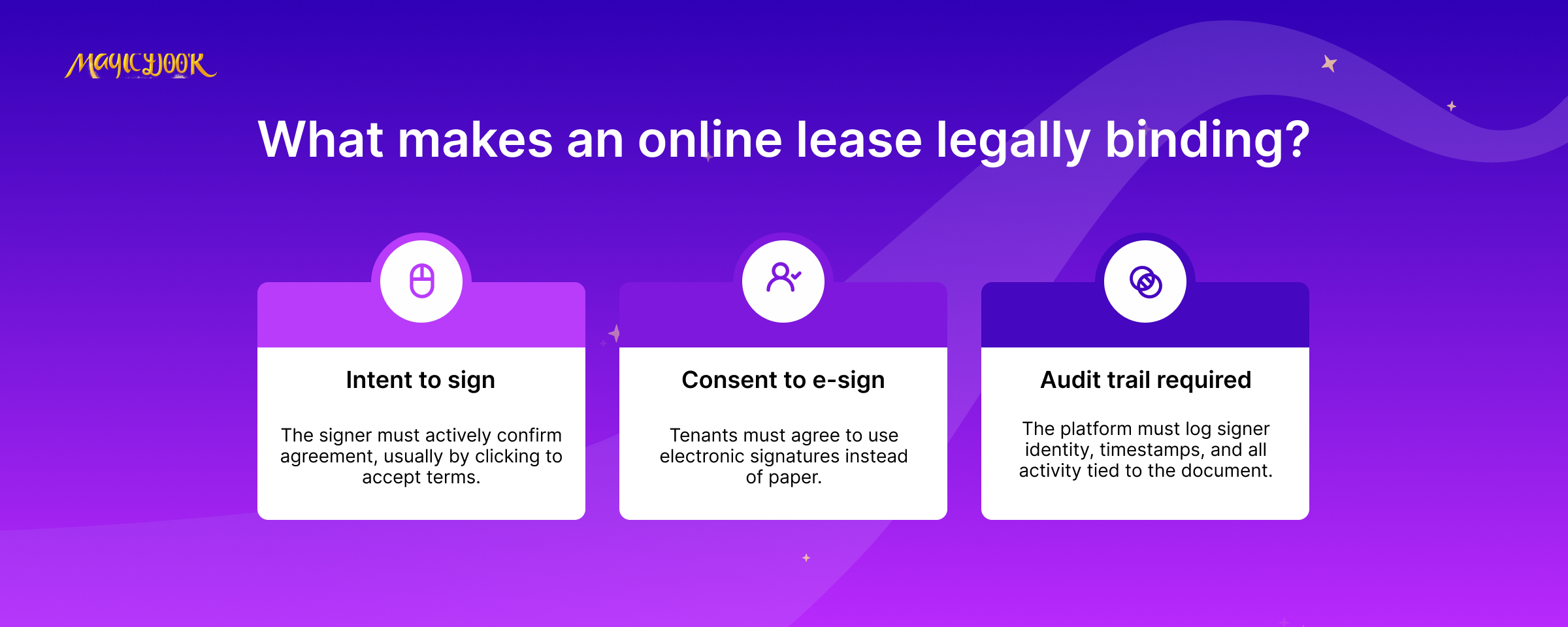
Those laws prohibit rejecting a signed lease solely because it’s electronic. To stand in court, a lease signed electronically needs:
- Intent to sign: Demonstrated when a user clicks "sign your lease online" to agree with the lease document.
- Consent to e‑sign: The tenant must agree to use an electronic signature rather than a paper one.
- Audit trail: The system must log identity verification, timestamps, IP addresses, and document changes.
When those checks are in place, document authenticity holds even for complex tenant lease agreements or rental agreement digital workflows
Electronic signature technology logs who signed, where, and when, and with signer consent, making it legally binding to sign a lease agreement electronically.
How Does An E-Lease Differ from Traditional Lease Signing?
While both types result in a signed rental agreement, the processes and benefits differ significantly.
Traditional lease signing requires physical presence, printing documents, and securing handwritten signatures from all parties. It often involves coordinating in-person meetings, using paper copies, and then storing signed documents in filing cabinets.
Errors like missing initials, unreadable handwriting, or forgotten addenda can lead to disputes or delays.
An electronic lease agreement replaces these steps with a digital signature workflow. After uploading the lease document to a secure platform, landlords or tenants electronically sign using a verified process. The system logs audit trails, captures timestamps, IP addresses, and signer identity.
That’s how it delivers a legally binding electronic signature comparable to ink on paper, under laws like ESIGN and UETA.
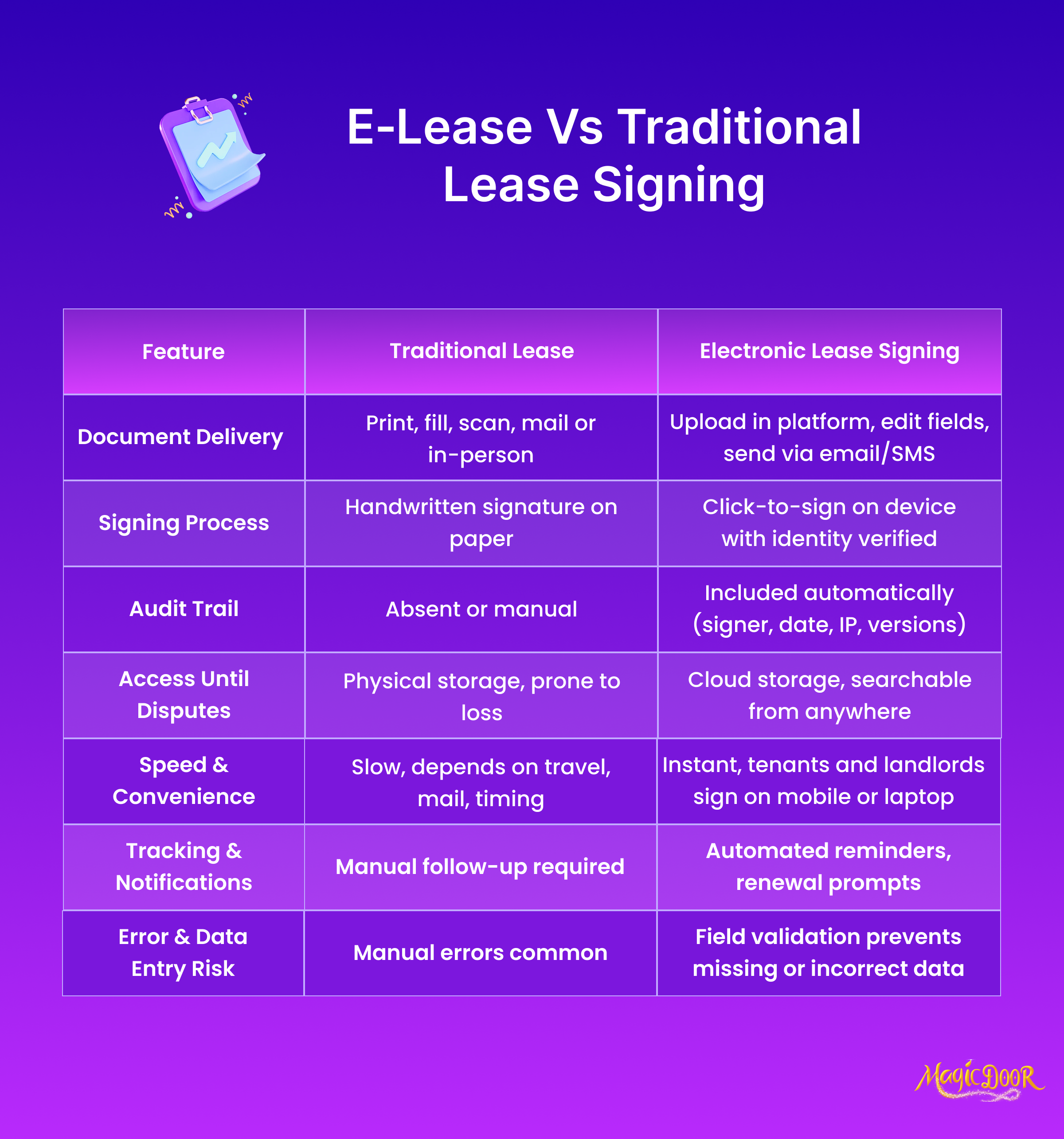
Most tenants appreciate the simplicity. They can sign a lease agreement online from a phone, laptop, or tablet in minutes. Platforms often autofill negotiated clauses, such as rent amount, lease dates, and tenant names, reducing manual document edits.
The digital version securely stores the complete lease agreement. It helps landlords enforce lease terms and tenants confirm important dates or conditions.
Plus, it supports greener practices by saving paper and cutting storage costs
Benefits of Electronic Lease Signing
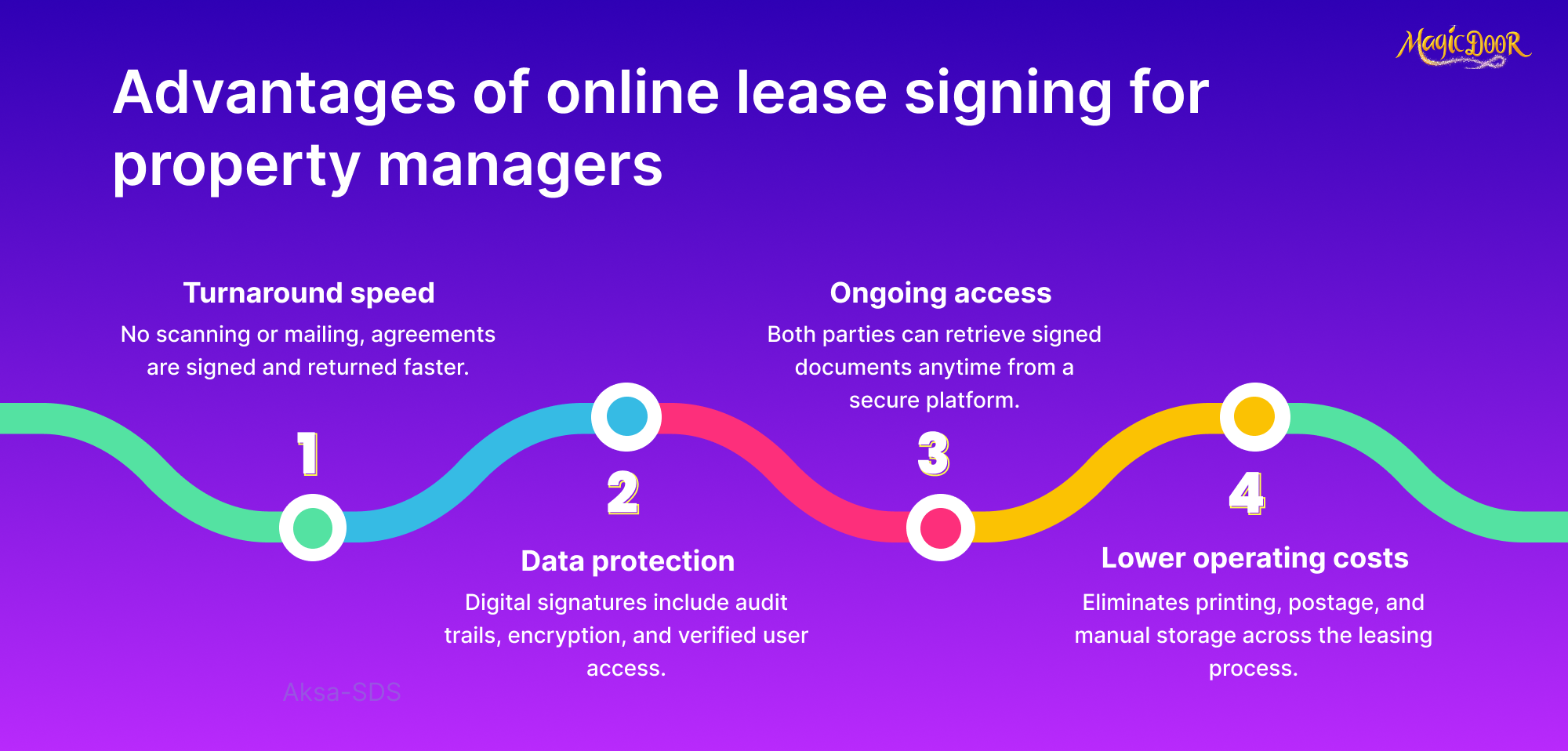
Sign from Anywhere With Convenience
Electronic lease signing lets landlords and tenants finish the process without meeting in person.
There’s no need to print, scan, or mail anything. You can sign your lease online in minutes, from a phone or laptop, ideal for renters relocating, managing properties remotely, or finalizing renewals during off-hours.
A typical lease agreement online allows all parties to electronically sign, complete fields like rent amount or move-in date, and access the completed lease agreement anytime. This improves turnaround time, cuts delays, and keeps the lease signing process simple.
Tenants also benefit from the ability to review terms at their own pace, whether preparing to list a rental property, ask questions, or request edits before committing to the signed lease. Landlords reduce no-shows and speed up vacancy turnover with faster agreement execution.
Data Protection
Security is a frequent concern with any online lease agreement, but reputable tools rely on bank-grade encryption and strict verification protocols. When tenants sign a lease online, the digital signatures are backed by identity checks and legally binding electronic signature frameworks like ESIGN and UETA.
Every signed document includes metadata that verifies who signed, when they signed, and from what IP address. That provides confidence that the signature belongs to the intended signer, and creates a permanent other record of consent.
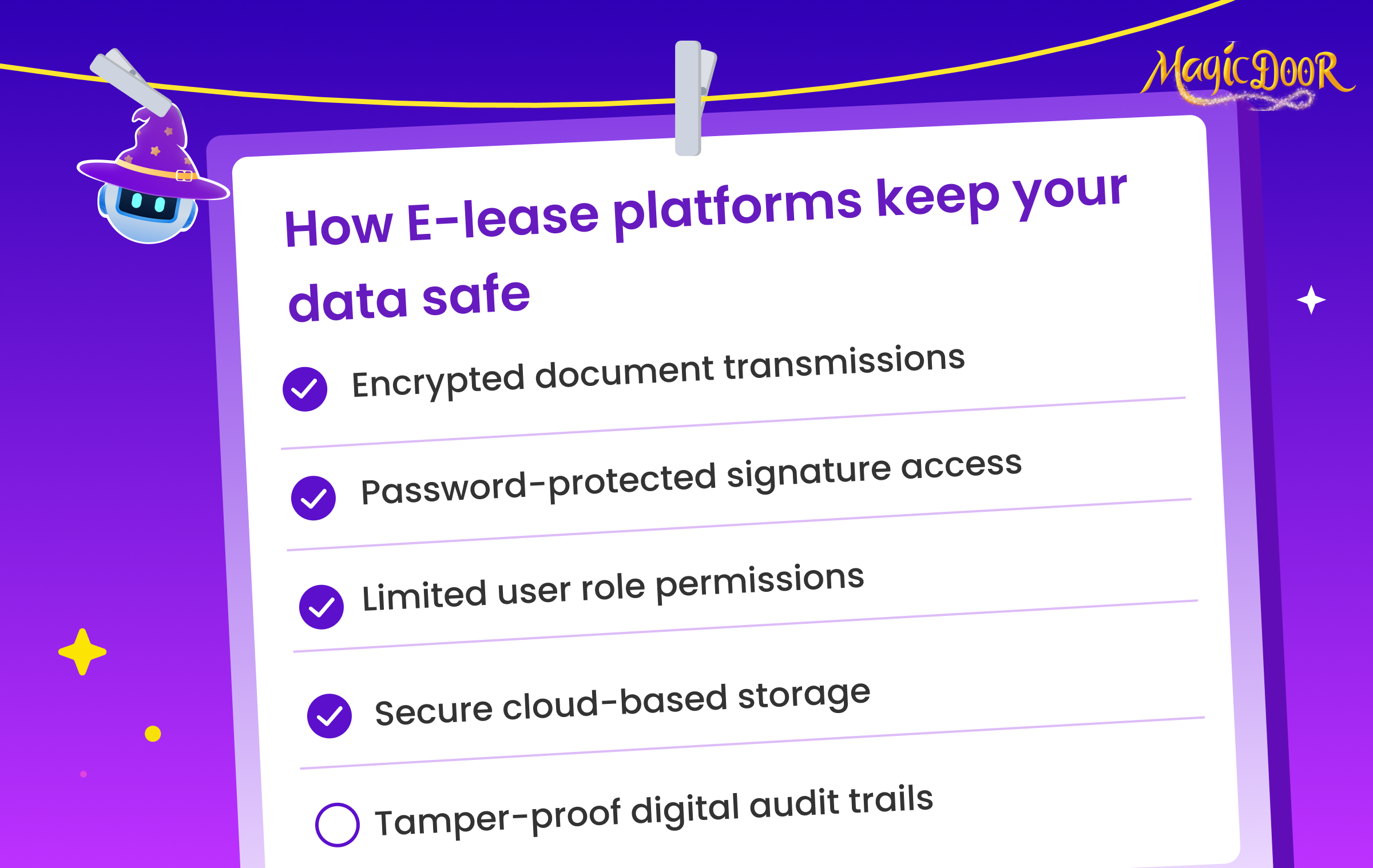
Landlords no longer need to store fragile paper copies.
Instead, they can access a searchable digital lease document that meets legal requirements and protects sensitive tenant data. Tools often limit access to verified users, log changes in real time, and provide automatic backups.
Tools that include a rental property maintenance checklist alongside lease records also help managers keep track of ongoing unit responsibilities.
For property managers working with units or locations, this central access supports consistent and secure compliance. Platforms like MagicDoor ensure MagicDoor keeps your information safe with encryption, limited access, and consistent audit tracking.
Recover Documents Anytime
Landlords and tenants often need to revisit signed lease agreements, but storing physical copies can lead to missing pages or misfiled paperwork. With an online lease, documents remain available through secure platforms, no matter where or when they’re needed.
Both parties can review the completed lease agreement to confirm terms like payment responsibilities, renewal options, rental house repairs, or move-out procedures. That cuts down on misunderstandings and eliminates the need for repeated requests or paper handling.
Electronic access supports better organization, especially for property managers handling dozens of tenant lease agreements or renters needing copies for applications or recordkeeping.
Reduce Costs With Paperless Signing
Electronic signature technology speeds up the process and cuts operational expenses tied to printing, scanning, and manual storage.
Landlords can avoid recurring supply costs, and tenants no longer need to travel or print paperwork just to sign a lease.
Every signed document is stored digitally, reducing the chance of missing files or incomplete agreements. Most platforms that let you sign your lease online also flag empty fields and send reminders, helping both sides finish the process without delays or rework.
How Electronic Lease Signing Works
Select Document
Initiating the electronic lease signing process begins with uploading the lease document to a secure platform.
Property managers or landlords ensure files include all necessary details, such as the lease period, property address, and specific negotiated fields. The platform often allows users to create customized online leases, enabling adjustments for unique requirements.
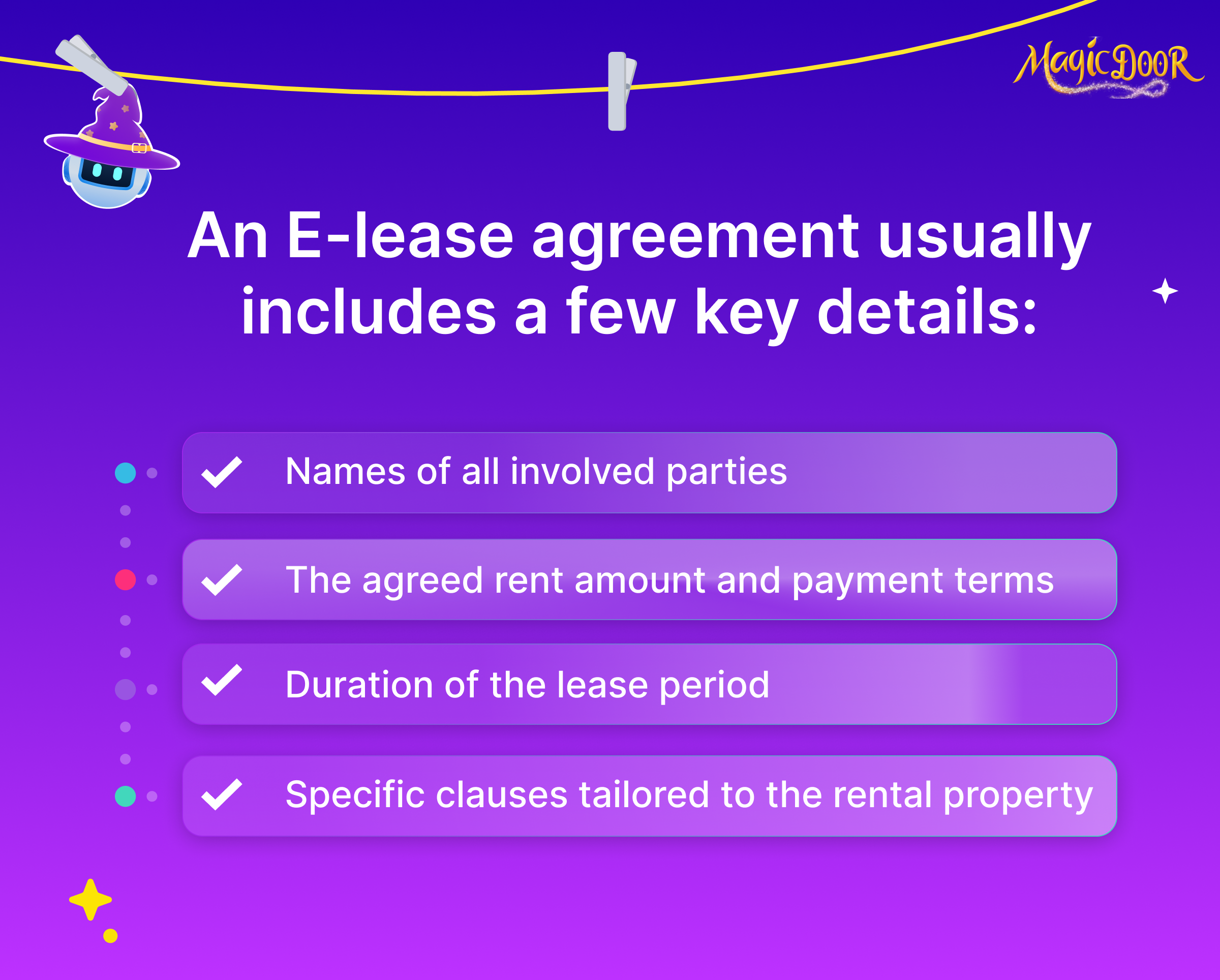
Many landlords explore how to transition to property management software at this stage to unify lease prep, tenant onboarding, and payments in one place
Key details typically included in the uploaded agreement are:
- Names of all involved parties
- The agreed rent amount and payment terms
- Duration of the lease period
- Specific clauses tailored to the rental property
These features make lease preparation smooth and more accurate than manual methods, ensuring clarity for all parties.
Add Signers
Once the lease document is prepared, the next step is to specify the individuals who need to sign. Landlords add tenants, co-signers, or any additional parties involved in the agreement.
Modern electronic signature technology is crucial for validating each participant’s identity through encrypted verification.
When adding signers:
- You identify all required participants by their email or other secure credentials.
- Customize the fields for each signer to clarify where and what needs to be signed.
- Grant limited access to safeguard the document’s confidentiality.
Send for Signature
Once everything is prepared, the document is sent for tenant approval.
Email or system-generated notifications prompt participants to review and e-sign the agreement wherever they are. The process is designed to be user-friendly, whether they’re accessing it via a tablet, phone, or desktop.
This step makes the signing process efficient by offering:
- Instant notifications for participants, reducing delays
- Clear guidance to prevent errors or omitted fields during signing
- Compatibility with multiple devices, providing flexibility for tenants on the move
Receive Signed Copy
After all parties agree and sign electronically, the system generates a finalized, tamper-proof copy for everyone involved. This means both landlords and tenants receive a legally binding document, complete with an audit trail that records essential actions like:
- The date each signature was applied
- Locations from which the agreement was accessed and signed
- Any edits or changes made during the process
The audit trail proves particularly valuable for resolving disputes or verifying compliance with lease terms. When disputes come up over maintenance or wear and tear, having clear rental house repairs responsibilities for landlords outlined in the signed lease prevents confusion.
Tenants and landlords get peace of mind knowing that their rental agreement is fully secure and verified.
Store Securely
The finalized lease is stored securely in a digital archive when the signing process concludes. This eliminates the risks of lost or damaged paper records and allows instant retrieval.
Benefits of digital storage include:
- Cloud access enables landlords to manage agreements across properties in regions like New Mexico or Florida.
- Reduced reliance on physical storage, which can lead to clutter and logistical challenges
- Eco-friendly practices by going paperless, reducing environmental impact
For landlords managing multiple rental properties, this step simplifies compliance by keeping tenant lease agreements organized and accessible. Stored documents remain protected and easy to locate if needed for audits or tenant inquiries.
Legal Considerations for Electronic Lease Signing In The US
Electronic lease agreements are legally valid across all 50 U.S. states, thanks to two key federal laws: the ESIGN Act (2000) and UETA (Uniform Electronic Transactions Act). These laws confirm that digital signatures carry the same legal weight as handwritten ones, as long as both parties agree to use electronic records.
A legally binding electronic signature must show clear intent and consent and secure a record of who signed and when.
Most platforms that support lease agreement online workflows already meet these standards, which include audit trails, IP tracking, and timestamped actions to confirm authenticity.

Landlords using platforms to electronically sign a lease must ensure:
- The rental agreement is accessible to both parties before signing.
- Both tenants and landlords can review, download, or print a signed document.
- There’s no pressure or lack of consent, every agreement must be voluntary.
- The digital signatures are tied to specific individuals through verifiable credentials.
While online lease agreement platforms make signing fast and simple, not all templates are enforceable in every state. Some states have stricter rules around lease duration, renewal terms, or disclosures.
If you’re unsure, check local laws or consult a property attorney. Some states vary requirements based on the types of residential properties involved, such as single-family homes versus multi-unit rentals.
Common Challenges With E-Lease Agreements
Technical Difficulties
Even with advancements in electronic lease signing, technical issues remain a common obstacle.
Problems may include the platform freezing during use, device compatibility concerns, or errors loading the agreement for review. These disruptions can frustrate users and delay signing timelines, especially if tenants or landlords rely on older hardware or incompatible software.
Internet connectivity also plays a role in ensuring the signing process doesn’t stall mid-step.
To avoid such issues:
- Ensure the software supports various browsers and devices.
- Test run any updates to prevent unexpected glitches.
- Provide offline options for regions with unreliable network access.
User Resistance
Not all users immediately trust or feel comfortable with digital agreements. Some individuals may prefer traditional methods or feel uneasy about adopting unfamiliar technology.
Elderly clients or those with limited experience using online systems may find the process intimidating. Building trust through clear instructions and offering support during each step helps address hesitations.
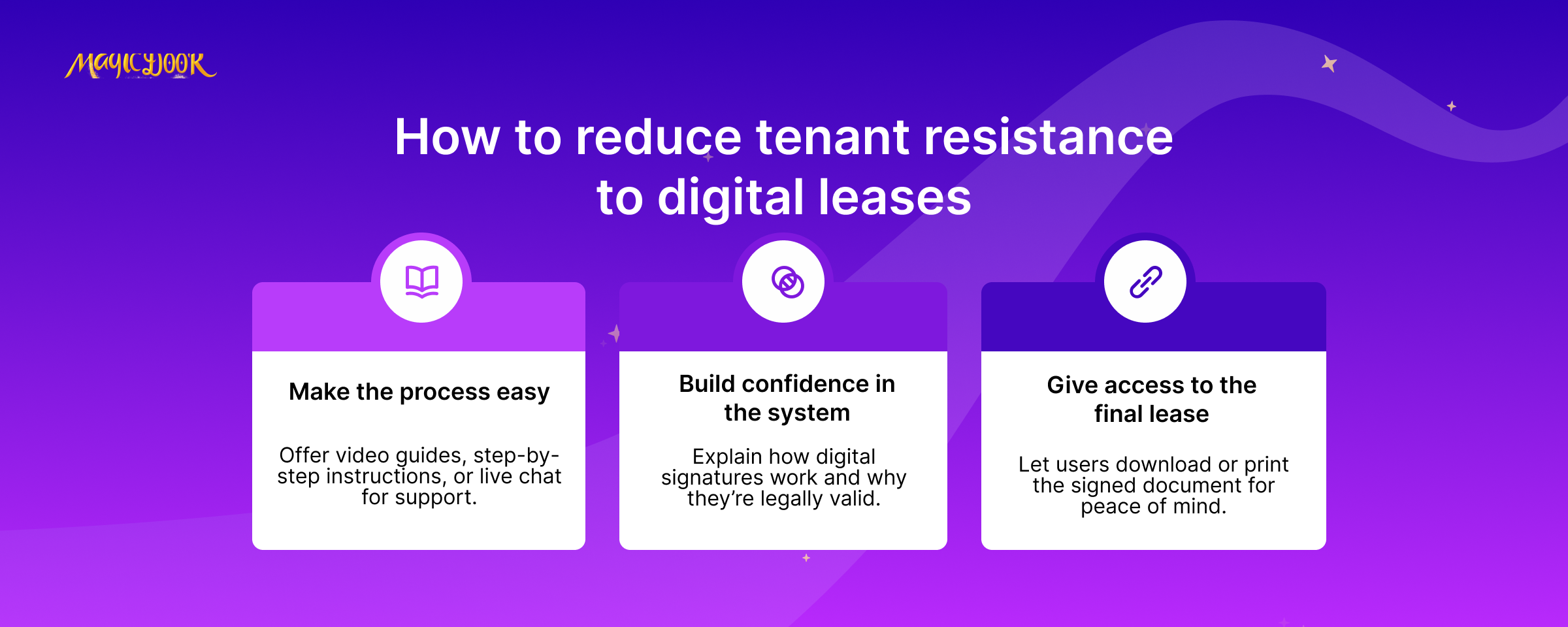
Strategies to ease resistance:
- Offer a step-by-step video guide or live chat assistance.
- Reassure users of system security and legal validity.
- Provide access to a downloadable copy of the signed lease for personal records.
For tenants leasing in community-managed buildings, understanding the benefits of living in a HOA can also ease concerns about digital lease adoption.
Legal Compliance
Dealing with the various legal frameworks for electronic lease signing can be challenging.
Differences in state requirements and interpretations of federal acts like the E-SIGN Act may confuse landlords and tenants. Detailed clauses regarding identity verification, tenant rights, electronic acknowledgment, and proper data storage vary between states, adding complexity to the process.
Key legal concerns include:
- Aligning agreements with both state and federal laws.
- Including proper disclosure statements regarding digital consent.
- Maintaining secure and compliant document storage methods.
Data Security Concerns
Landlords and property managers must prioritize the safety of tenant data shared during leases.
Hackers targeting system weaknesses or unsecured connections can cause breaches, exposing sensitive information such as personal identification details, rental property addresses, or bank account numbers.
This raises concerns about how platforms manage and protect agreements digitally.
How to improve security:
- Use encrypted networks and multi-factor authentication for file access.
- Regularly update software to block vulnerabilities.
- Audit all past activity logs to detect suspicious patterns.
Platform Limitations
Sometimes, the electronic lease signing system may fail to accommodate all landlord or tenant needs.
Common frustrations include complex interfaces, an inability to modify certain document sections, or restrictions on assigning unique signing fields. Such limitations can complicate signing workflows and prevent smooth customization of lease agreements.
To overcome these issues:
- Choose platforms offering flexible tools for customized online leases.
- Ensure devices support mobile-friendly and desktop-friendly options.
- Test usability before committing to a platform or subscription plan.
Top Electronic Lease Signing Tools
DocuSign
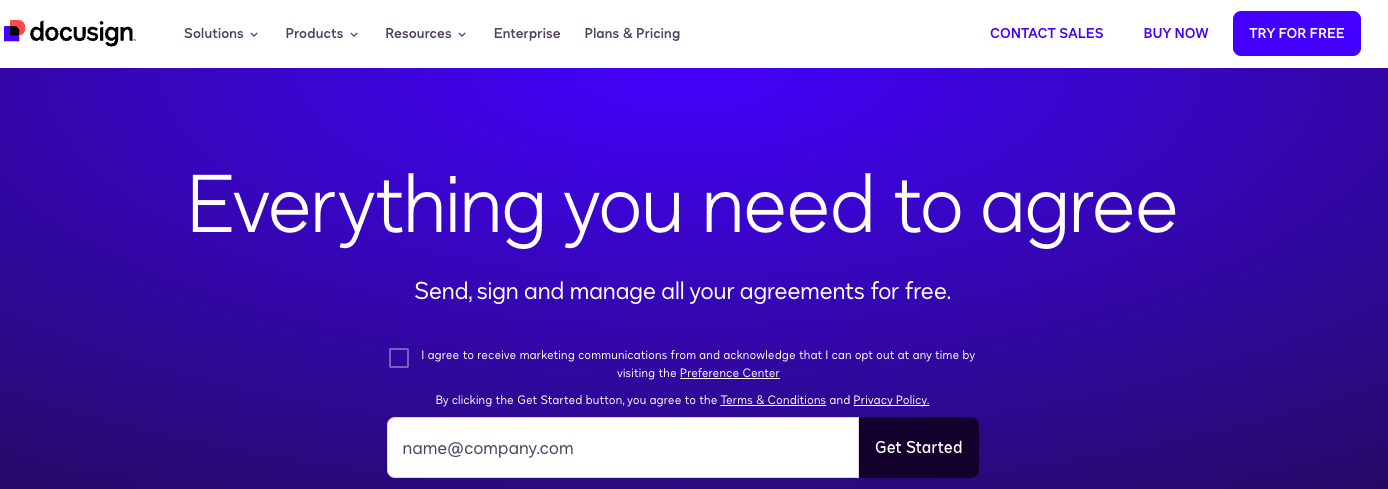
DocuSign has long been a leader in electronic lease signing and agreement management.
Trusted globally by over a billion users and employed by 95% of Fortune 500 companies, it has set a high standard for e-signature platforms. This tool offers solutions in more than 44 languages, allowing businesses to easily send, sign, and manage contracts.
Its state-of-the-art features enable agreements to be completed quickly and securely, reducing manual processes and improving accessibility. DocuSign provides a streamlined way to handle lease agreements, especially for property managers and renters who value efficiency and accuracy.
DocuSign’s Main Features
- Electronic signatures: Easily send, view, and sign contracts using DocuSign’s secure platform, designed to be accessible on mobile devices and desktops.
- Compliance and security: DocuSign complies with stringent global security standards, protecting tenant and landlord information during the electronic lease signing.
- Intelligent Agreement Management (IAM): Supports every stage of the rental agreement lifecycle, helping simplify edits, updates, and long-term tracking of signed documents.
- Customizable fields: You can customize documents by creating unique signing fields for tenants, landlords, or other parties.
- Audit trails: Real-time tracking ensures transparency by recording every change or action taken during the digital signing process.
- Integrations: Connect with widely used tools like Google Drive, Salesforce, and Microsoft Office for improved functionality.
Who is DocuSign Best For?
DocuSign is ideal for property managers, landlords, and tenants seeking a reliable electronic signature solution that meets legal standards.
It’s particularly effective for professionals managing multiple rental agreements who need a scalable and efficient platform. This applies equally to firms operating in the commercial real estate markets, where multi-unit lease handling requires speed and legal precision.
The tool is also invaluable for businesses prioritizing compliance and requiring advanced data protection during the signing process.
Xodo Sign
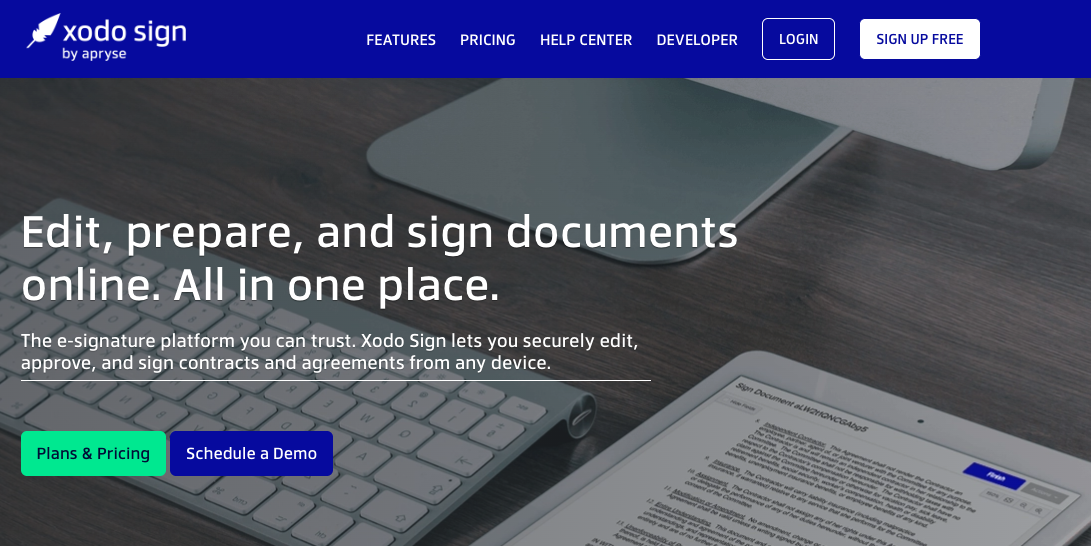
Xodo Sign, formerly known as Eversign, offers a user-friendly electronic lease signing solution to simplify document management.
With its ability to securely handle contracts and signatures, this platform is for individuals, small businesses, and large organizations. Whether finalizing a lease on a mobile device or preparing it at the office, Xodo Sign ensures accessibility for all parties involved.
The platform provides peace of mind regarding sensitive data with encryption measures and reliable performance. Users can sign, send, and approve documents online from anywhere without sacrificing speed or security.
Xodo Sign’s Main Features
- Electronic signature support: Sign contracts directly on mobile, desktop, or tablet devices, enabling remote and in-person document completion.
- High-level security: Advanced encryption ensures that important lease details are safeguarded during every step of the signing process.
- Template creation: Save time by creating reusable templates for frequently used lease agreements to eliminate repetitive tasks.
- Multidevice capability: The tool can be operated across multiple devices, allowing users to approve or sign documents on platforms like smartphones, laptops, or tablets.
- Cloud integration: Connect with storage tools, such as Dropbox, OneDrive, and Google Drive, to securely and manageably store lease agreements.
- API for automation: Incorporating electronic signatures into existing systems using the platform’s easy-to-implement API.
Who is Xodo Sign Best For?
This tool works exceptionally well for property managers who manage lease agreements simultaneously and need an organized platform. Freelancers managing smaller rental portfolios also benefit from its efficiency.
Additionally, it simplifies compliance for enterprises by offering robust encryption and in-person signing options.
Yousign
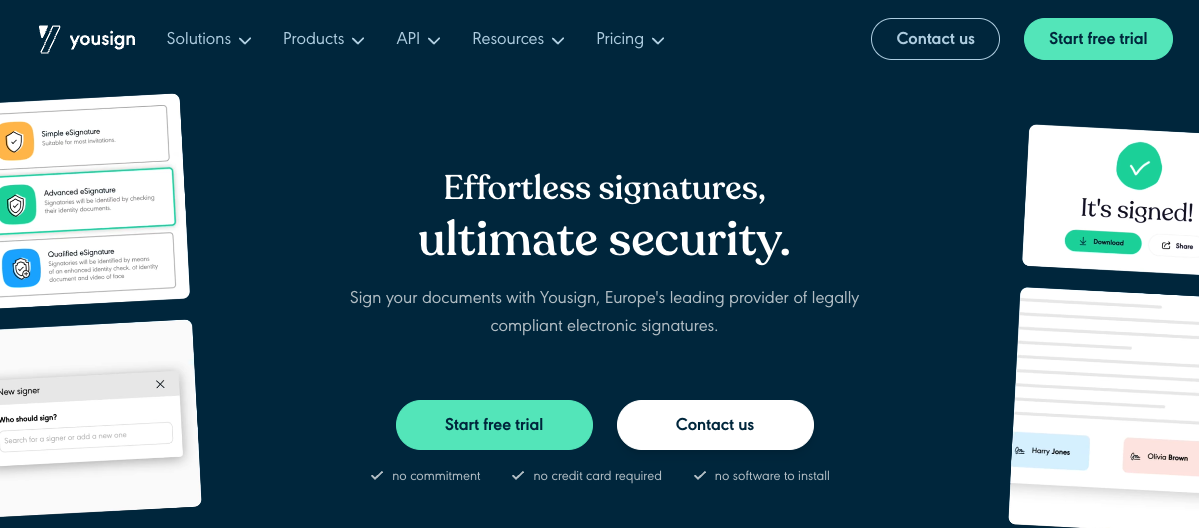
Yousign is a dependable e-lease signing solution for small and medium-sized businesses (SMBs).
The platform, known for adhering to European eIDAS regulations, ensures legally binding digital signatures. It simplifies how businesses handle agreements, offering a seamless process for creating, sending, and securing documents.
With strong compliance measures and user-friendly tools, Yousign meets the needs of those requiring a reliable signing experience across various industries.
Yousing’s Main Features
- Legally compliant signatures: Yousign supports different levels of digital signatures, from simple to qualified, ensuring suitable security for diverse document needs.
- Intuitive interface: The application is intuitive and helps users manage and execute digital agreements quickly without extensive training.
- Secure storage and management: Advanced encryption safeguards documents, allowing businesses to archive and access agreements confidently.
- Personalized experience: Customize workflows to reflect your business’s requirements, adding flexibility to the signing procedures.
- Multilevel authentication: OTP (one-time password) and video ID verification ensure robust protection against unauthorized access.
- Business applications integration: Yousign’s API option enables integration with existing tools, enhancing efficiency without disrupting established processes.
Who is Yousign Best For?
Yousign is perfect for SMBs in industries that rely on secure, compliant digital agreements, such as real estate, education, and software.
Teams handling sales, HR, or procurement will find their intuitive interface especially helpful for expediting workflows. It’s also ideal for organizations requiring flexible options, from basic OTP authentication to in-depth video ID verification for sensitive documents.
From managing leases to finalizing NDAs, Yousign offers an efficient electronic lease signing and contract management approach without compromising compliance or security.
Conclusion
Electronic lease signing has moved past early adoption, it’s now a standard practice for property managers and landlords managing multiple units or seeking faster lease turnaround.
With built-in legal compliance, timestamped audit trails, and centralized storage, digital agreements reduce risks while saving time. Many platforms now double as property management software for small landlords, bundling lease tools with rent collection and communication features.
But not every platform is designed with property management in mind.
If you’re looking for a rental management tool that handles lease signing and the daily tasks of collecting rent, responding to maintenance requests, and tracking tenants, MagicDoor combines all of that in one clean interface, no subscriptions, no complicated setup.
Simplify your lease process and your operations. Check out MagicDoor to see how easy it can be.
Frequently Asked Questions
What is electronic document signing?
Electronic document signing allows parties to digitally approve and sign agreements through secure online platforms, eliminating physical paperwork.
Does DocuSign have leases?
Yes, DocuSign supports lease agreements. It provides customizable templates and tools for efficiently creating, sending, and managing signed leases.
What is online leasing?
Online leasing refers to the digital process of creating, reviewing, and signing rental agreements. Secure online tools allow leases to be finalized remotely.
Is an electronic signature legally binding?
Yes, an electronic signature is legally binding in most regions, as long as it complies with local laws like the ESIGN Act in the U.S. or eIDAS in the EU.

